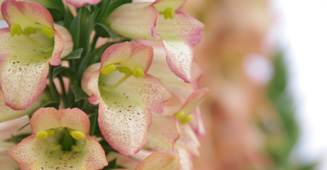

Contributor
- Topics: Archive
Seed security and responsible horticultural practices are important topics. Following the publication of our story about Digitalis ‘Illumination Flame’ in the Fall 2014 issue we heard from a couple of readers expressing concern about the development of sterile plants and their impact on the environment. We appreciate the input and are thankful for readers who feel strongly enough about an issue to contact us.
Pacific Horticulture—and our contributors—believes in beautiful gardens that are connected to the world at large. We value good design and environmental responsibility equally. This perspective is reflected in our coverage of the many natural systems at work in the landscape including pollinator support, beneficial insects, alongside stories about beautifully designed gardens and recent plant introductions. Certainly seed genetics is a part of this lively mix. As gardeners—and publishers—we want to see gardens that cooperate with nature; after all, we are a part of nature.

[pullquote]At Pacific Horticulture we value good design and environmental responsibility equally.[/pullquote]
Yes, Digiplexis is a sterile hybrid, a factor that is responsible for its extended bloom period. For years sterile hybrid ornamental perennials, like Verbascum hybrida ‘Copper Rose’, Geranium ‘Johnson’s Blue’, ‘Ann Folkhard’, and ‘Rozanne’, many hybrid Echinacea, Meconopsis, and other foxgloves have become gardener and designer favorites for their long season of floral interest and have been wildly successful in the marketplace. The fact that these plants are seed sterile does not necessarily mean that they don’t have environmental benefits beyond their beauty in the landscape as many still provide habitat and forage for wildlife and the soil food web.
A garden is not created from a single plant and diversity is the foundation of an interesting landscape as well as the preservation of valuable genetic material. There is a great deal of damage being perpetrated in today’s seed industry—particularly in the world of food. On the flip side of this topic, we’ve seen the damage that can happen when non-sterile ornamental plants escape cultivation and threaten the native landscape.
Our editorial conversation at Pacific Horticulture attempts to cover the many wonderful complexities and nuances of the garden; a topic much larger than any single article can encompass. I appreciate the thoughtfulness and passion expressed by all our readers. Please check out our next issue, winter 2015, for an article from Matthew Hoffman, the founder of The Living Seed Company—a community dedicated to seed saving and preserving genetic diversity for the present and future generations.
Best regards,
Lorene Edwards Forkner, editor
Steve Gerischer, PHS board president
Share:
Social Media
Garden Futurist Podcast
Most Popular
Videos
Topics
Related Posts

Low Maintenance Gardens – Better for Pollinators and People
Autumn 2022 “I come out every day. It’s therapy, my meditation.” Janet’s young garden transformed from overgrown, invasive plants to mostly natives. The dailiness of

Calochortophilia: A Californian’s Love Affair with a Genus
Summer 2022 I can chart the progression of my life by Calochortus. For the last two decades, at least. As a teenage girl growing up

Pacific Plant People: Carol Bornstein
Spring 2022 Public gardens play a key role in demonstrating naturalistic planting design, selecting native and adapted plants for habitat, and testing techniques for reducing

Add Year-Round Interest and Winter Blooms for Pollinators
Spring 2022 This article was created from an Interview by Merrill Jensen with Neil Bell in the Summer of 2021 for our Pacific Plant People










Responses